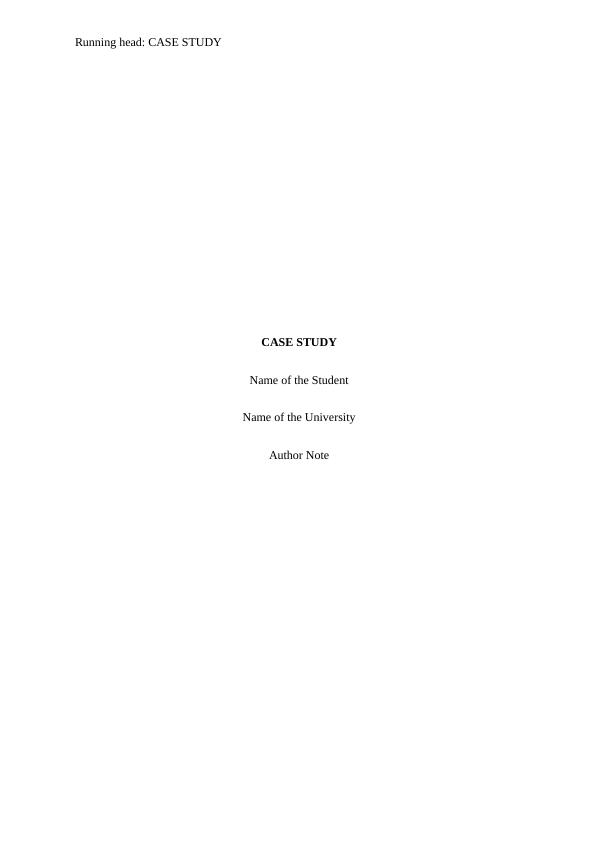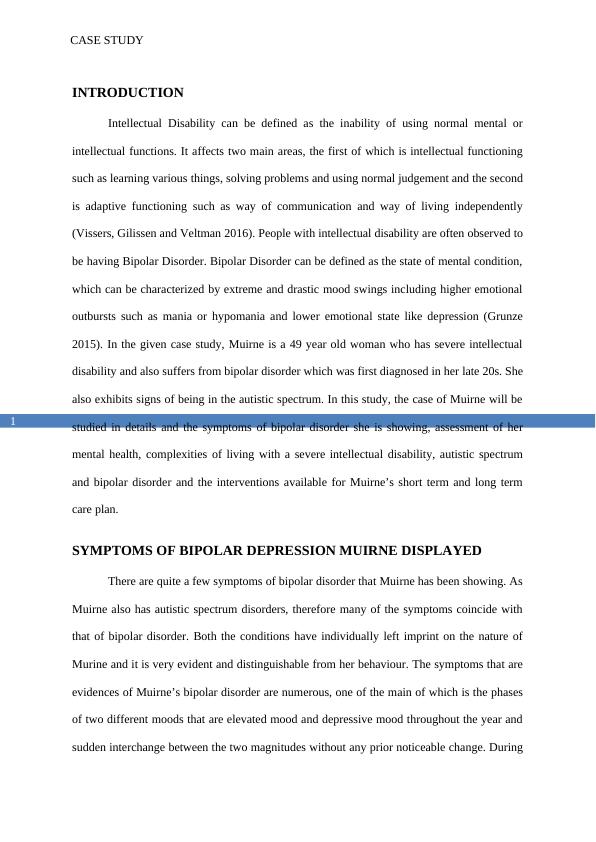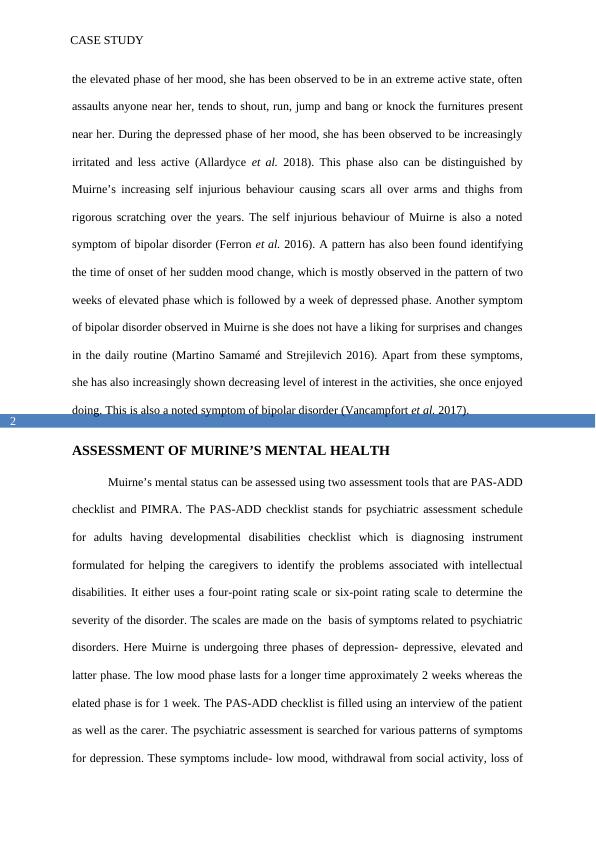Few Symptoms of Bipolar Disorder
Added on 2022-09-05
11 Pages2967 Words21 Views
Running head: CASE STUDY
CASE STUDY
Name of the Student
Name of the University
Author Note
CASE STUDY
Name of the Student
Name of the University
Author Note

CASE STUDY
1
INTRODUCTION
Intellectual Disability can be defined as the inability of using normal mental or
intellectual functions. It affects two main areas, the first of which is intellectual functioning
such as learning various things, solving problems and using normal judgement and the second
is adaptive functioning such as way of communication and way of living independently
(Vissers, Gilissen and Veltman 2016). People with intellectual disability are often observed to
be having Bipolar Disorder. Bipolar Disorder can be defined as the state of mental condition,
which can be characterized by extreme and drastic mood swings including higher emotional
outbursts such as mania or hypomania and lower emotional state like depression (Grunze
2015). In the given case study, Muirne is a 49 year old woman who has severe intellectual
disability and also suffers from bipolar disorder which was first diagnosed in her late 20s. She
also exhibits signs of being in the autistic spectrum. In this study, the case of Muirne will be
studied in details and the symptoms of bipolar disorder she is showing, assessment of her
mental health, complexities of living with a severe intellectual disability, autistic spectrum
and bipolar disorder and the interventions available for Muirne’s short term and long term
care plan.
SYMPTOMS OF BIPOLAR DEPRESSION MUIRNE DISPLAYED
There are quite a few symptoms of bipolar disorder that Muirne has been showing. As
Muirne also has autistic spectrum disorders, therefore many of the symptoms coincide with
that of bipolar disorder. Both the conditions have individually left imprint on the nature of
Murine and it is very evident and distinguishable from her behaviour. The symptoms that are
evidences of Muirne’s bipolar disorder are numerous, one of the main of which is the phases
of two different moods that are elevated mood and depressive mood throughout the year and
sudden interchange between the two magnitudes without any prior noticeable change. During
1
INTRODUCTION
Intellectual Disability can be defined as the inability of using normal mental or
intellectual functions. It affects two main areas, the first of which is intellectual functioning
such as learning various things, solving problems and using normal judgement and the second
is adaptive functioning such as way of communication and way of living independently
(Vissers, Gilissen and Veltman 2016). People with intellectual disability are often observed to
be having Bipolar Disorder. Bipolar Disorder can be defined as the state of mental condition,
which can be characterized by extreme and drastic mood swings including higher emotional
outbursts such as mania or hypomania and lower emotional state like depression (Grunze
2015). In the given case study, Muirne is a 49 year old woman who has severe intellectual
disability and also suffers from bipolar disorder which was first diagnosed in her late 20s. She
also exhibits signs of being in the autistic spectrum. In this study, the case of Muirne will be
studied in details and the symptoms of bipolar disorder she is showing, assessment of her
mental health, complexities of living with a severe intellectual disability, autistic spectrum
and bipolar disorder and the interventions available for Muirne’s short term and long term
care plan.
SYMPTOMS OF BIPOLAR DEPRESSION MUIRNE DISPLAYED
There are quite a few symptoms of bipolar disorder that Muirne has been showing. As
Muirne also has autistic spectrum disorders, therefore many of the symptoms coincide with
that of bipolar disorder. Both the conditions have individually left imprint on the nature of
Murine and it is very evident and distinguishable from her behaviour. The symptoms that are
evidences of Muirne’s bipolar disorder are numerous, one of the main of which is the phases
of two different moods that are elevated mood and depressive mood throughout the year and
sudden interchange between the two magnitudes without any prior noticeable change. During

CASE STUDY
2
the elevated phase of her mood, she has been observed to be in an extreme active state, often
assaults anyone near her, tends to shout, run, jump and bang or knock the furnitures present
near her. During the depressed phase of her mood, she has been observed to be increasingly
irritated and less active (Allardyce et al. 2018). This phase also can be distinguished by
Muirne’s increasing self injurious behaviour causing scars all over arms and thighs from
rigorous scratching over the years. The self injurious behaviour of Muirne is also a noted
symptom of bipolar disorder (Ferron et al. 2016). A pattern has also been found identifying
the time of onset of her sudden mood change, which is mostly observed in the pattern of two
weeks of elevated phase which is followed by a week of depressed phase. Another symptom
of bipolar disorder observed in Muirne is she does not have a liking for surprises and changes
in the daily routine (Martino Samamé and Strejilevich 2016). Apart from these symptoms,
she has also increasingly shown decreasing level of interest in the activities, she once enjoyed
doing. This is also a noted symptom of bipolar disorder (Vancampfort et al. 2017).
ASSESSMENT OF MURINE’S MENTAL HEALTH
Muirne’s mental status can be assessed using two assessment tools that are PAS-ADD
checklist and PIMRA. The PAS-ADD checklist stands for psychiatric assessment schedule
for adults having developmental disabilities checklist which is diagnosing instrument
formulated for helping the caregivers to identify the problems associated with intellectual
disabilities. It either uses a four-point rating scale or six-point rating scale to determine the
severity of the disorder. The scales are made on the basis of symptoms related to psychiatric
disorders. Here Muirne is undergoing three phases of depression- depressive, elevated and
latter phase. The low mood phase lasts for a longer time approximately 2 weeks whereas the
elated phase is for 1 week. The PAS-ADD checklist is filled using an interview of the patient
as well as the carer. The psychiatric assessment is searched for various patterns of symptoms
for depression. These symptoms include- low mood, withdrawal from social activity, loss of
2
the elevated phase of her mood, she has been observed to be in an extreme active state, often
assaults anyone near her, tends to shout, run, jump and bang or knock the furnitures present
near her. During the depressed phase of her mood, she has been observed to be increasingly
irritated and less active (Allardyce et al. 2018). This phase also can be distinguished by
Muirne’s increasing self injurious behaviour causing scars all over arms and thighs from
rigorous scratching over the years. The self injurious behaviour of Muirne is also a noted
symptom of bipolar disorder (Ferron et al. 2016). A pattern has also been found identifying
the time of onset of her sudden mood change, which is mostly observed in the pattern of two
weeks of elevated phase which is followed by a week of depressed phase. Another symptom
of bipolar disorder observed in Muirne is she does not have a liking for surprises and changes
in the daily routine (Martino Samamé and Strejilevich 2016). Apart from these symptoms,
she has also increasingly shown decreasing level of interest in the activities, she once enjoyed
doing. This is also a noted symptom of bipolar disorder (Vancampfort et al. 2017).
ASSESSMENT OF MURINE’S MENTAL HEALTH
Muirne’s mental status can be assessed using two assessment tools that are PAS-ADD
checklist and PIMRA. The PAS-ADD checklist stands for psychiatric assessment schedule
for adults having developmental disabilities checklist which is diagnosing instrument
formulated for helping the caregivers to identify the problems associated with intellectual
disabilities. It either uses a four-point rating scale or six-point rating scale to determine the
severity of the disorder. The scales are made on the basis of symptoms related to psychiatric
disorders. Here Muirne is undergoing three phases of depression- depressive, elevated and
latter phase. The low mood phase lasts for a longer time approximately 2 weeks whereas the
elated phase is for 1 week. The PAS-ADD checklist is filled using an interview of the patient
as well as the carer. The psychiatric assessment is searched for various patterns of symptoms
for depression. These symptoms include- low mood, withdrawal from social activity, loss of

CASE STUDY
3
interest, guilt, energy loss, exhaustion, loss of hope, loss of sexual activities. For having a
mild depressive episode, the criteria include sustained depressive mood for atleast two weeks
along with either low energy or reduced interest in activities. In case of Muirne, who shows
depressive mood for two weeks and also has loss of interest in engaging into activities
therefore meets the criteria for mild depression. Any symptoms additional to these symptoms
would result in moderate to severe form of depression as rated by the scale, where the severe
form is the highest scale. For a six factor dependent PAS-ADD checklist, a questionnaire is
prepared with items related to psychotic disorders. The content of items include disturbances
in the basic habits of the patient, anxiety, psychosis which were not present in case of
Muirne, however she showed symptoms of depression such as irritable behaviour and
cognitive symptoms such as loss of interest (Martorell et al. 2017).
PIMRA is another diagnosing instrument for screening people with intellectual
diability. The rating of various items of psychotic disorders are done by the carers, family
members or known people of the patient. PIMRA is represented by seven classes of
psychological disorders that include schizophrenia, anxiety, somatoform disorder,
psychosexual disorder, personality disorder, affective disorder and adjustment disorder with
another subscale that measures inappropriate adjustment (Disabilityconsultants.org, 2020).
These seven classes refer to seven factors where each factor include various items depending
on which the patient’s mental state is to be judged. The factors to which Muirne’s condition
was associated is given below in the table-
Factor no Factor name Present or not
(yes/no)
1 Anxiety No
2 Adjustment issue Yes (aggressive behaviour)
3 Somatoform disorder Yes (depressive thoughts)
4 Schizophrenia No
5 Affective disorder Yes (mood changes)
6 Personality disorder Yes (bipolar disorder)
3
interest, guilt, energy loss, exhaustion, loss of hope, loss of sexual activities. For having a
mild depressive episode, the criteria include sustained depressive mood for atleast two weeks
along with either low energy or reduced interest in activities. In case of Muirne, who shows
depressive mood for two weeks and also has loss of interest in engaging into activities
therefore meets the criteria for mild depression. Any symptoms additional to these symptoms
would result in moderate to severe form of depression as rated by the scale, where the severe
form is the highest scale. For a six factor dependent PAS-ADD checklist, a questionnaire is
prepared with items related to psychotic disorders. The content of items include disturbances
in the basic habits of the patient, anxiety, psychosis which were not present in case of
Muirne, however she showed symptoms of depression such as irritable behaviour and
cognitive symptoms such as loss of interest (Martorell et al. 2017).
PIMRA is another diagnosing instrument for screening people with intellectual
diability. The rating of various items of psychotic disorders are done by the carers, family
members or known people of the patient. PIMRA is represented by seven classes of
psychological disorders that include schizophrenia, anxiety, somatoform disorder,
psychosexual disorder, personality disorder, affective disorder and adjustment disorder with
another subscale that measures inappropriate adjustment (Disabilityconsultants.org, 2020).
These seven classes refer to seven factors where each factor include various items depending
on which the patient’s mental state is to be judged. The factors to which Muirne’s condition
was associated is given below in the table-
Factor no Factor name Present or not
(yes/no)
1 Anxiety No
2 Adjustment issue Yes (aggressive behaviour)
3 Somatoform disorder Yes (depressive thoughts)
4 Schizophrenia No
5 Affective disorder Yes (mood changes)
6 Personality disorder Yes (bipolar disorder)

End of preview
Want to access all the pages? Upload your documents or become a member.
Related Documents
Simulated Mental Health Client Care Setting - Assessmentlg...
|18
|4264
|339
Psychology: Bipolar Disorderlg...
|8
|1520
|405
Mental Health Recovery Focussed Care Planlg...
|9
|2086
|80
Psychopathology: Understanding and Treating Psychological Disorderslg...
|15
|890
|165
Mental Healthcare Assignment (Case Study Analysis)lg...
|9
|2452
|377
Child psychology: a scientific study of developmental changeslg...
|16
|4815
|82
